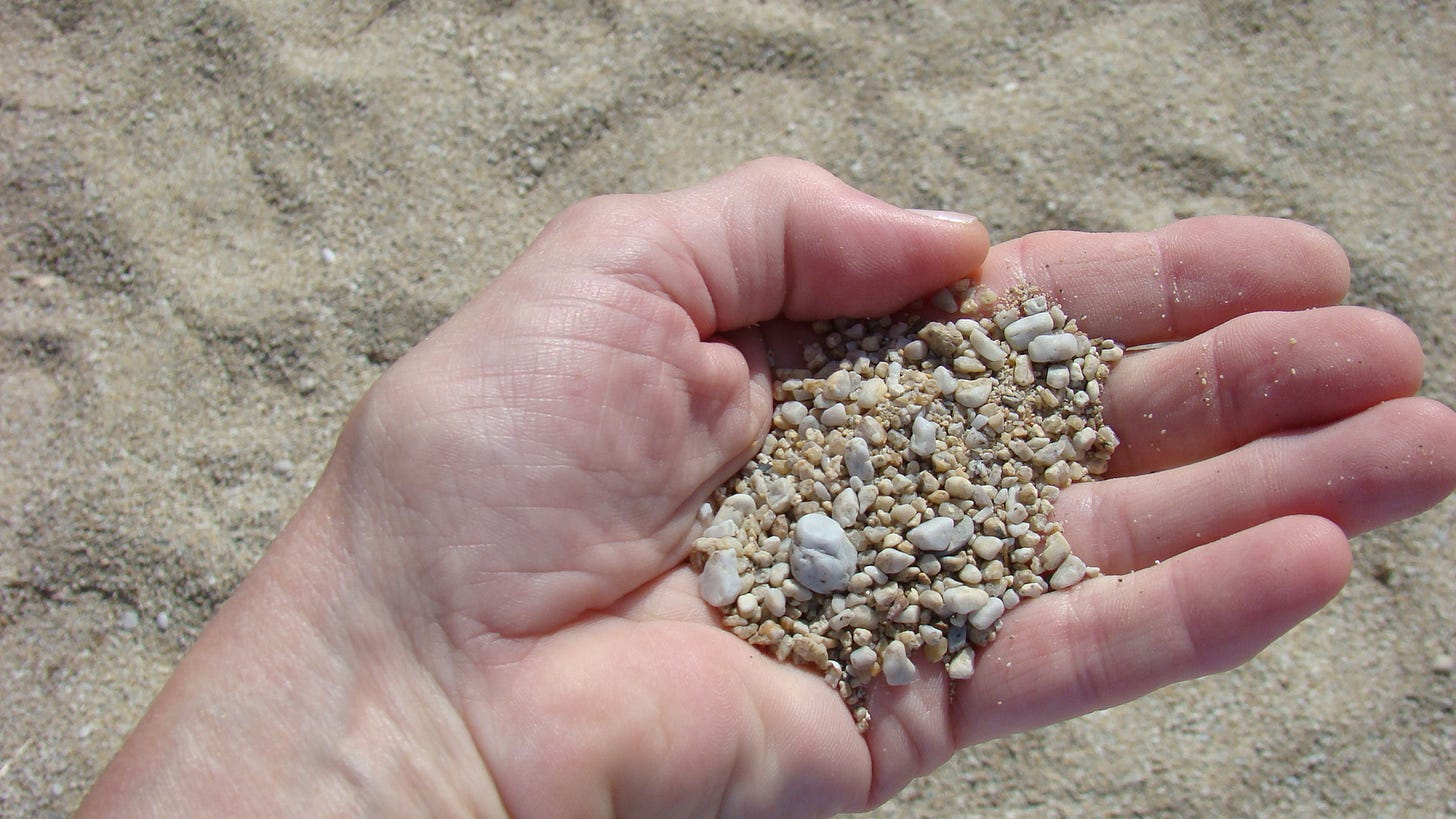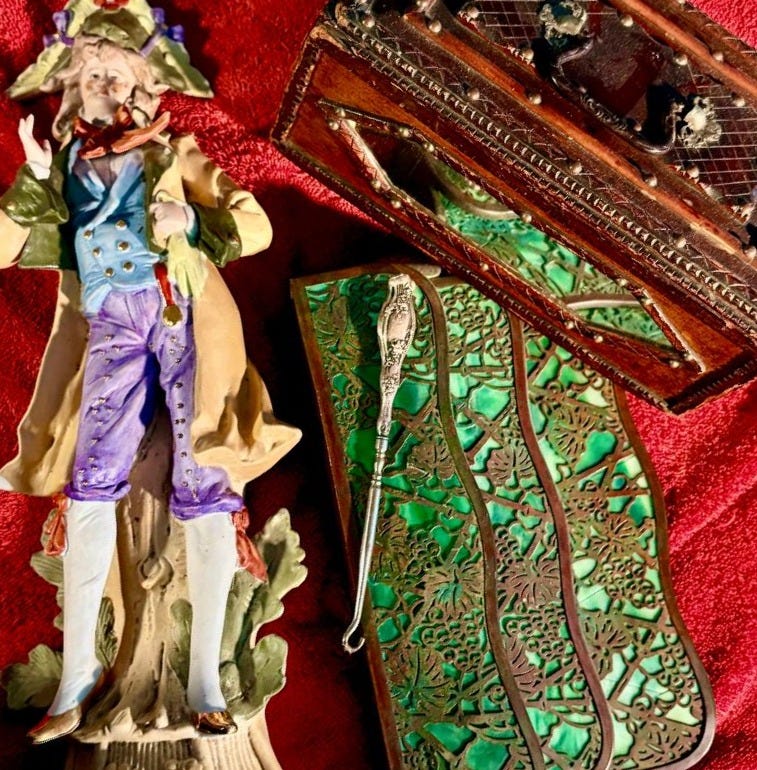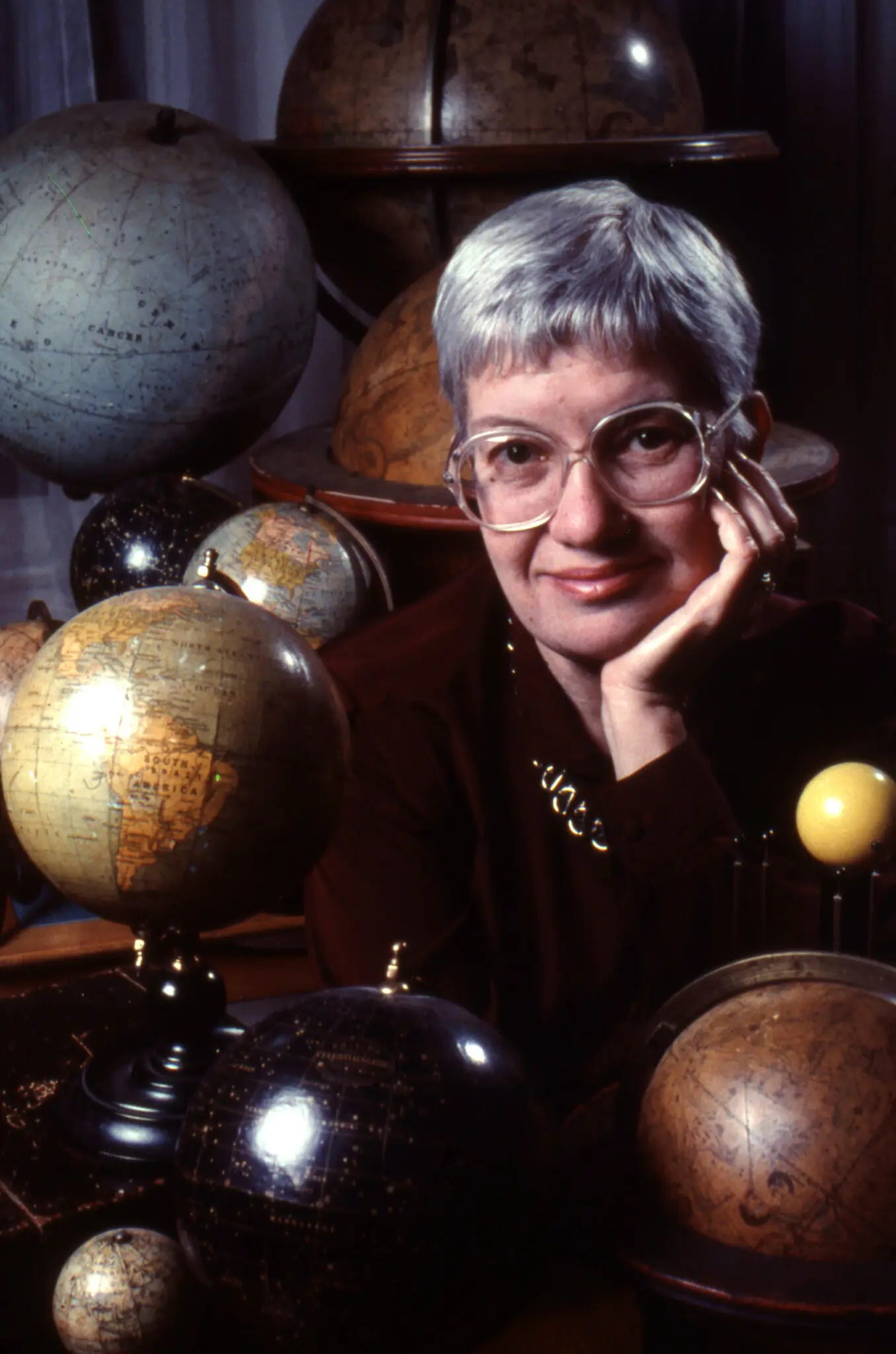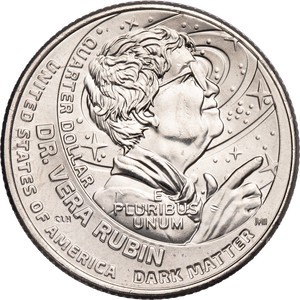QUIDDITY, 87
It Became More than That's "The Pack Rat Chronicles, Part 3," Meanderings' "The Fleury Way, Part 2," and W!cked Schoo!marms
It Became More than That
From the time she was 15 until her passing in 2018, writing was an ever-present influencer in Leah Napolin’s life. Writing provided her with the platform to observe and comment on the events and people that were consequential in her world, - from the minute to the universal, from YENTL to THE DOGS OF PRYPIAT. Future issues of QUIDDITY will provide you with the opportunity to become familiar with some of her insights. **********
THE PACK RAT CHRONICLES
by LEAH NAPOLIN
PART 3
(Part 2 ended with Leah observing: “There was also a watchdog, and a .22 caliber handgun kept next to the cash register. The gun was unloaded and intended merely for show. The bullets were kept at home in the top drawer of the sideboard, next to the hurricane candles and the good teaspoons. I've often wondered what would have happened if an intruder had broken into our house. What would we have done—thrown the bullets at him?” )
Years went by, and even though the signs in my father's shop window, yellow with age, still advertised their fabulous bargains and sell-outs, he became more reluctant than ever to part with anything. He was 78 when a circulatory problem cost him his right leg. For a man who had spent his life accumulating things as if they were an extension of Self, to have given up part of his mortal self was an almost unendurable insult. He grieved for his lost limb, off somewhere in the Heaven of Lost Things, along with his keys and his cane and his hat and his lunchbox. Yet he fought back, wasted little time feeling sorry for himself, learned to wear a prosthesis, had his car outfitted with special hand controls, and rented another store.
Trying to stay afloat in the path of such fierce determination wasn't easy. At one point, my mother, sister and I planned a yard sale. While we busied ourselves downstairs, he sat at an upstairs window, thinking he was unobserved, a pair of binoculars pressed to his eye, watching it all in a paroxysm of fear that his neighbors were pocketing his precious things and walking off with them.
Ten years later, after he had gone into a nursing home, we organized another one. Grandchildren, cousins, friends, everyone pitched in to help. That night, when we went to visit him, we found him confined to bed, incoherent and covered with bruises.
"What happened?" we demanded to know.
The nurse told us that on that morning, at the very hour the yard sale began, he became extremely agitated. Left unsupervised for a minute, he managed to wheel himself down the corridor, pull open a steel fire door and, still in his wheelchair, plunge down a flight of concrete stairs.
"They're selling my things—" I imagined him crying. "I've got to get home!"
It's now six years since my father's death, and he continues to be a presence in our lives. Sometimes, like the passing breeze that strikes a chord on the wind chime, I feel the breath of his love and remember the gentle, gregarious man with the joke and the ready smile, who knew lots of people but had no close friends; the man who felt most comfortable with children—juggling broom handles on his nose, singing old vaudeville songs, doing card tricks and imitations of barnyard animals—yet had no gift for parenting.
Other times, the presence is a more driven one. I can feel it when I step into the garage or the basement, booby-trapped with memories, and catch a whiff of that claustrophobic odor. Dampness, brittleness, rot. Each time I cross the threshold, each time I divest myself of one more thing, I voice a silent apology to the ghost that inhabits those premises.
A few years ago we decided to replace the front porch. When the floor boards were pulled up we found underneath, to our amazement, a basement room that had been padlocked for so many years we'd forgotten about it. Donning work gloves and surgical masks, we began hauling out the contents of the room using an improvised rope-pulley system. Neighbors came by to see what was going on. It was an archeological dig of no historical importance, except to us. Our history as a family was in that room.
Teetering with each step on the brink of disaster, we took turns going down the ladder and filling up the bucket, handing up boxes of buttons and nails and doorknobs and cans of solidified paint, some with their paintbrushes still standing upright in them, like artifacts from Pompeii. Locks for which there were no keys, and keys which fit no locks. Dime store frames with no pictures, and pictures with no frames—the kind called Swank, usually a photo of someone famous, like a movie star or a President. We counted 34 Rita Hayworths and 77 FDR's. Steel thumbtacks which had rusted so badly they couldn't be pried apart, fused into one giant thumbtack. And the parts for a combination lamp, humidor and ashtray, all faux marble and plastic wood and white metal spray-painted the color of bronze, which we reassembled on the lawn. I remembered seeing it as a child—a sort of Thurber-ish invention belonging in only your better motel rooms. It was one of his more popular sale items.
As the day wore on and night came, work continued under floodlights and I grew feverish, joyful, inventorying my father's fortune—not the riches we had dreamed and speculated about for years, the hidden stashes we knew for sure would one day come to light, but things of indeterminate value possessing, nevertheless, a life of their own. We had descended into Tut's tomb and, instead of gold diadems or collars made of lapis lazuli, came up with lamp parts made of chrome and crystal whose facets sparkled in the moonlight like real gems, and wistful porcelain cherubs that had long ago fallen off their pedestals.
There, in the same cigarbox I used to keep under my bed, were the last remnants of the miniature hand-blown glass menagerie he let me play with, always with the proviso that I handle them carefully so as not to break them. Kitchen table dioramas, my fascination: life on the African veldt, Alice down the rabbit hole. Oops, there goes an elephant's trunk! There goes the cat's tail! Gone forever.
(to be continued)
###
MEANDERINGS: “The Fleury Way, Part 2”
(Part 1 ended with our grade schooler kneeling in the O’Donald’s living room, praying the rosary with both the radio and her “chosen family.” )
More often than not, half a block away on Fleury Way, my mom cleared and washed the dishes I had abandoned in a rush after another threesome dinner. With my first communion rosary beads stuffed into the pocket of my jeans, I pedaled my bike furiously over the cobblestones to the O’Donalds because it was very important that I be there at seven o’clock. I was part of a community.
On any given day, unaware of the psychology, I pedaled toward the breezy chatter, the clattering pots and pans, the squabbles over crayons and coloring books, the assigned chores, the expected cooperation and sharing. I pedaled away from being the center of attention, away from the silent hum of being the only child. I was that girl on the beige 24” Schwinn who wanted to be an integral part of a community. A community that did not revolve around me but rather around the well-being of ten people and their pets. And, as an only child, I wanted to be included in this very special family dance.
One of the communal dance steps was “Red” O’Donald’s making cabbage juice to treat his ulcers. This was a weekly family enterprise that included all the kids, including me. We all pitched in to create the smelly medicine that he drank everyday, usually before dinner.
The commitment and dedication to preparing the medicinal veggie juice could have been a model for the Ford assembly line. We all knew the script by heart, each of us with a specific task. The little ones gathered the cabbages (2-3) and placed them in the sink. Beth removed the leaves, and Timmy washed them and placed them on a towel on the long kitchen table. Once dry, Butch and Eddie chopped the leaves into even squares, making neat 2 cup piles of one inch pieces. Virginia inspected the mounds and made certain all was in order, including a ladle, and a large container of water sitting to the left of the blender. Cathy checked to make certain the blender was firmly in place and plugged in. My job was to arrange a large bowl and a line up of jars to the right of the blender. Once all was ready, Mr. O’Donald would be called to “finish the job.”
Like a true scout master, Red would look around, and ask, “Everybody ready? One, two, three, hold your nose and yell PEEEE-UUUU!”
Complying and giggling, we marched to our designated positions. When everyone was in place, Mr. O’Donald lifted his right arm and gave the order, “Okay, let’s go.”
And, go we did, in-time, on task. Mr. O’Donald’s troop turned the cabbage squares and water into his magic, stinky elixir.
The three oldest, plus yours truly, would collect, slowly strain the potent juice into a huge, stainless steel bowl, and ladle it into the waiting jars. Mrs. O’Donald had the final responsibility of making certain the lids were firmly in place. Butch and Eddie were charged with depositing the left-over pulp into a dedicated compost heap against the rear fence in the back yard.
No matter what anyone else thought, this was magical to me. We all worked together for a goal that was real and had consequence. I was proud of the outcome and proud that I was part of something that was bigger than me, and I wanted to share the outcome of this experience.
I wanted to offer my mom some cabbage juice to help treat her ulcers. I wanted my mom to feel better like Red did. I wanted my mom to feel the love and effort that went into making the juice. Always willing to share, Red filled a small glass jar with some of the juice. I gently put it into the bike’s handlebar basket and slowly chauffeured it home. Proudly and hopefully, I offered it to mom. She opened the jar and let out a shriek.
“Oh, good lord. This smells like days-old rotting garbage.” She quickly threw it down the drain, carefully washed the jar, and told me to give it back to Red with her thanks.
“You will NOT say anything about my not liking it and throwing it away. Is that clear, Barbie?”
I followed mom’s instructions and never asked for a refill to take back to 7521 Fleury Way. The weekly cabbage drill continued and so did my love of being a part of the O’Donald community.
Meanwhile, almost a full block north on Fleury Way, lived the O’Sheas whom I had designated as my “chosen” relatives: two grandparents, two aunts, one uncle, one cousin, plus one blue parakeet. But, that’s another story best told over dessert. &
###
W!cked Schoo!marms takes ownership of this outdated opprobrium and turns it into a lens that focuses on women who are current or former teachers, instructors, professors -- Women with extraordinary talents that they have employed to teach skills, art, ethics, science, math, history, problem solving. Creative, talented women who have also encouraged and nourished the development of curiosity, empathy, creativity, commitment. **********
How could I ignore my dearest lifetime friend, Martha, a board member of the National Women’s History Alliance, when she texted, “Thanks for your recent, almost visionary ‘Meandering.’ Here is your Women's History Lesson for the month: VERA RUBIN is awesome, and maybe next issue you can tell a bit about her.” I couldn’t disregard the possibility that many QUIDDITY readers may not be familiar with Vera Rubin. So, it’s my honor to introduce you to VERA RUBIN (1928-2016) after whom The Vera C. Rubin Observatory is named — and a truly cosmic W!icked Schoo!marm.
Dr. Rubin began her career teaching Mathematics and Physics at Montgomery College and as a research associate astronomer, lecturer, and assistant professor of astronomy at Georgetown University. There, she presented her first observations of galaxy rotation while collaborating with Geoffrey and Margaret Burbidge. Vera Rubin coined and postulated the concept of and belief in BLACK HOLES when other scientists had no idea that Black Holes had a framework. Her observations confirmed the theory of dark matter, and her activism helped open science to more women.
Vera Rubin’s scientific accomplishments were always accompanied by her advocacy for women, especially women in science. Beginning her career in the 1960s, she faced constant barriers as a woman. She balanced her profession with her marriage to John and raising four kids. With courage and perseverance, she continued studying science no matter how strongly her male advisors told her that she should give it up. In 1963, Vera became the first woman to legally put her hands on the Palomar Observatory’s telescopes that had denied access to women. Throughout her career, Dr. Rubin continued her campaign to help other women navigate the very male-dominated fields of physics and astrophysics.
The list of her achievements and contributions to science and women’s rights is much too long and complicated to review here, but below are a few to consider:









